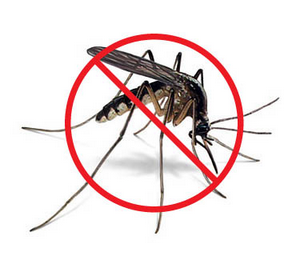Recommendations to Avoid Mosquito Breeding
WHERE TO LOOK AND WHAT TO DO:
IN CEMENT OR PLASTIC POOLS.
Operate the filter and skimmer everyday to remove eggs and larvae. Provide drainage for filter and sump pumps. Chlorine does not kill mosquito larvae. If a pool cover is used, keep it tightly sealed. Remove the rainwater that accumulates on top of the pool cover. If the pool is green and stagnant, do not introduce mosquito-eating fish (Gambusia afinis), because children and animals can be attracted to these light reflecting fish. It is difficult and sometimes impossible to see beneath the surface of a dense water mass of algae.
ORNAMENTAL WATER SOURCES.
Keep these sources with mosquito-eating fish. You can add goldfish if desired for aesthetic reasons. Avoid spraying with garden insect sprays.
Remove leaves and water lilies. Keep the water level high. Check the circulation pump. Chlorine kills fish, so fish should be moved to a bowl when cleaning the fountain. If the fountain is no longer in use, make holes at the bottom of the pan and fill it with soil or sand.
SEPTIC TANKS (LOCAL DIRTY WATER TREATMENT SYSTEM).
Maintain your septic tank according to the manufacturer’s recommendations according to the number of users and type of drainage. Inspect and replace the screen that protects the access door, also inspect the septic tank on a regular basis. A pipe with access to open drainage may be the ideal place for mosquitoes and other insects to thrive and breed.
BIRD BATHS, WATER BOWLS FOR ANIMALS.
Keep these places where there is water full of fish that eat mosquitoes. Birdbaths and water bowls should be washed at least once per week.
OTHER CONTAINERS.
Remove and dispose of all unused containers that can collect rain or irrigation water. These include bottles, barrels, old tires, tubs, etc. Toys such as containers or trucks must be stored upside down when not in use.
POTENTIAL WATER COLLECTORS.
Half an inch of standing water can breed hundreds of mosquitoes. Identify and move objects that can potentially hold water, such as patio furniture, garden tools, water hoses and garden ornaments. Inspect and clean water channels that the spring rains can leave and also after storms and strong wind conditions. When leaving plants and roots in pots to later plant in your garden, try to clean the water at least once a week.
BRIEF BIOLOGY OF SPECIES:
Tiger Mosquito
The tiger mosquito (Aedes albopictus) belongs to the family Culicidae and is characterized by the colour of its abdomen and legs with sharp black and white stripes. It has a length of about 5 mm. Like other mosquito species, the female has a long and slender tube, the proboscis, which, like a punch, used to bite and take blood from mammals, which uses the protein they need for the development of the eggs. Males of the species, like that of other mosquitoes feed on nectar.
It is an invasive species native to Southeast Asia, having spread throughout America and Europe since 1979 and subsequently by the Pacific. It is believed that its arrival may have occurred during the transport of persons or goods with remains of standing water such as discarded tires, ornamental plants such as bamboo, etc.
In Europe, it has been detected in Albania, Italy, France, Belgium, Switzerland, Hungary, Montenegro and Greece. In Catalonia (Spain), their presence was reported in the 2004 summer.
The tiger mosquito breeds in niches where there are small amounts of water are especially in shady places such as gardens with plants and abundant grass.
In some countries where it has spread, the fight against its eradication is difficult and very expensive, so it is suitable to act as early as possible by raising awareness among institutions and citizens to prevent this spread. Among the actions proposed are: Avoid potential reservoirs for mosquito breeding such as containers, pots, cans or any other utensil in which the water cannot be refilled at least once a week.
We recommend the use of insect repellents containing N, N-diethyl-(DEET) when you are outdoors, taking into account the instructions and precautions related to the product. The mosquito has four life stages: egg, larva, pupae, and adult. The larvae and pupae are always in the water.
Mosquitoes use water to complete their life cycle. The artificial stagnation of water provides the most optimal conditions for mosquito breeding, not stagnation or natural waterways. The mosquito can complete its life cycle either in chlorinated water or wastewater. Most mosquitoes can develop with as little water as ½ inch of water or for example what is the depth of a bottle cap. During the warm days of summer, mosquitoes complete their life cycle: egg, larvae, pupae and finally adult, within seven days.
EGG: The most common mosquitoes lay egg rafts that float in the water. Each egg raft contains between 100 and 400 eggs. In a few days each raft egg becomes a larvae.
LARVAE: Each larva touches the water surface to breathe through a specialized tube called a siphon. It changes skin four times during these days of growth. It grows rapidly between each moult, resulting in a pupa in the fourth moult.
PUPA: Each pupa breathes through 2 tubes on its back. Pupae resemble fluttering commas. The adult mosquito grows inside the pupa until it is fully developed. In about two days of the pupa skin splits into two and an adult mosquito emerges very hungry.
ADULT: Each newborn adult mosquito rests on the surface of the water until it is strong enough to fly and feed. Both male and female mosquitoes feed on plant juices. Only the females bite and suck blood from humans and other mammals, birds, and reptiles. The proteins in the blood are used to produce eggs. Females lay eggs several days after starting to fly. Females live up to 15 days, but males live only a few days.
During the warm summer months, female mosquitoes can live up to 3 weeks. During the cold months of fall and winter, hibernating female mosquitoes lay their eggs the following spring.




